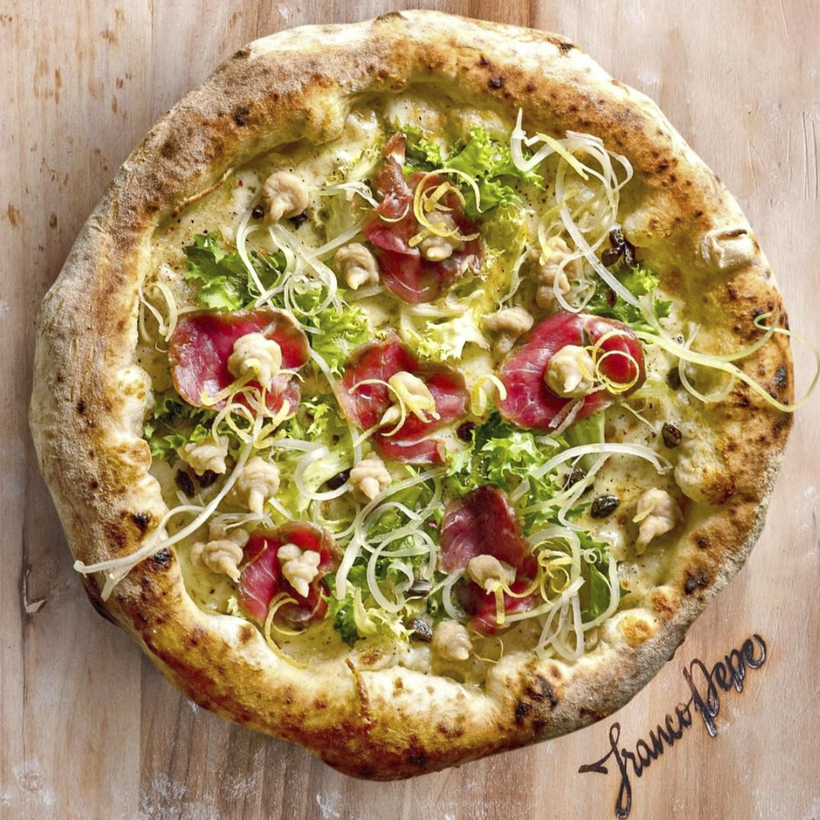The capital of pizza isn’t where you think it is. It isn’t New York, home of the long-perfected New York slice, or Naples and its Antica Pizzeria da Michele of Eat Pray Love fame. It isn’t even Caserta, known for the Reggia (the city’s majestic Bourbon palace rivaling Versailles in its extravagance and scale), the Camorra, and—critical for pizza—Italy’s best mozzarella.
The real capital of pizza is a tiny rural village in Southern Italy called Caiazzo. Getting there entails turning off the motorway an hour north of Naples and driving up dilapidated winding roads. For centuries Caiazzo was home to the Italian-village trifecta—a church, a café, and a funeral parlor—and not much else.
Today, the economy of Caiazzo, population 5,500, revolves entirely around the tourism generated from one exceptional pizzeria and its founder, 53-year-old Franco Pepe.
During World War II, when the Germans carried out the brutal Caiazzo massacre, in 1943, killing 22 civilians, Pepe’s grandfather, a breadmaker in the city, kept his oven running around the clock in order to feed villagers. He’s still remembered as a local hero.
Years later, Pepe’s father ran a pizzeria a few blocks away from where his own father’s once stood. But by the 60s and 70s, when Franco was growing up, Caiazzo was following the downward trend of virtually every other small town in Italy. Young people were leaving for the cities, shops were shuttering, and farmers were struggling to survive. “Everyone I knew was leaving town,” Pepe tells me. He himself moved to Milan to work as a postman.
When his father died, Pepe, who had in the meantime returned home to Caiazzo with his wife and sons, was determined to maintain the family pizza business. In 2011, he took out a loan and started renovations on a sprawling 18th-century building tucked away in a nondescript alley.
“When I opened Pepe in Grani [grani means “grain” in English], I had seven people working with me,” Pepe says. “I told them I’d do everything I could to make this work.”

He then did what no one in Italy dares to: he rethought centuries-old pizza recipes. “I wanted to maintain my family’s legacy,” Pepe, who learned how to make pizza from his father, says, “but I also wanted to make pizza as Franco Pepe.” His concoctions were unheard of in the traditional world of Italian pizza: pistachios, lemon zest, and ricotta; fondue, egg yolk, and bacon; there was even one with apricot jam and hazelnuts. But his most sacrilegious redesign took on the simple Italian classic—the pizza margherita.
Pepe’s Margherita Sbagliata (Mistaken Margherita) is made inside out. Plain mozzarella pies are cooked in a giant wood-fired oven for 60 to 90 seconds. Then cold tomato and basil extracts are added on the top. “Basil is essential,” Pepe explains, “but people hate chewing the whole leaf.”
At first, Caiazzans balked at his methods. “People thought I was completely crazy,” Pepe says. But by 2016, just four years after he opened his restaurant, the people of Caiazzo made their peace with the blasphemous menu, and Pepe’s “mistaken margherita” was awarded the Associazione Verace Pizza Napoletana prize for best pizza, triumphing over Naples’s historical spots.
Since then, tourists from all over the world have gone out of their way to eat at Franco’s. Journalists, restaurant critics, and well-known chefs, including Osteria Mozza’s Nancy Silverton, Nerua’s Josean Alija, and Osteria Francescana’s Massimo Bottura, have all waited in line at Pepe in Grani.
Yet eating at Franco’s continues to be an unpretentious experience. The décor, like that of all of Italy’s best restaurants, is sparse—white tablecloths, black chairs, and brick walls—and Pepe himself greets customers at the door, speaking Italian only.
As Caiazzo is a suburb of Caserta, Pepe in Grani follows the Casertan pizza tradition, favoring the “a cannotto” style (thick, airy crusts) over Naples’s “a ruota di carro,” (which is larger and spills off the plate).
Different variations of fried pizza are recommended as starters, and waiters help guests select pizzas in Pepe’s singular combinations for their main course. The dough is so light that sharing three to four pizzas is suggested for a group of two. A pizza costs around $9.
And the once somber town reverberates with life. Every night, around 700 people line up in front of Pepe in Grani in the hopes of snagging one of the restaurant’s 140 seats. The shops on Caiazzo’s main road have become boutiques, and new bars and restaurants have opened their doors. On Mondays, when the pizzeria is closed, most other establishments in town take the day off and the streets are silent, bar the occasional church bell.
When his restaurant was closed due to the pandemic, Pepe made pizza and cakes for elderly residents. “Thank God for Pepe,” an older woman in town tells me. Approximately 14,000 visitors now flock to Caiazzo every month.
Though Pepe has traveled to the U.A.E. to make pizzas for the sheikh and consulted for restaurants in Geneva, Hong Kong, and Franciacorta, Northern Italy’s wine country, he spends most of his time with his family and his team in Caiazzo.
When asked if he’d ever leave, Pepe says, “Achieving what I have achieved here today is the most important thing. I’m staying.”
Pepe in Grani, in Caiazzo, Italy, is open Tuesday through Sunday from 6:30 P.M. to midnight
Elena Clavarino is an Associate Editor for AIR MAIL


